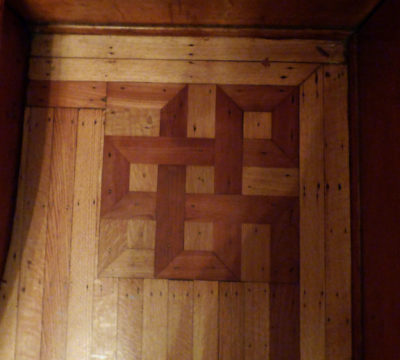Originally published November 2016
 One of my favorite features of the Lamson House is the wood floors. When we bought the house, the floors were showing serious signs of wear and in some areas, they were badly damaged. They were the very first thing in the house that we had restored because replacing them would be impossible. That is because most of the wood floors are tiger oak with walnut inlays.
One of my favorite features of the Lamson House is the wood floors. When we bought the house, the floors were showing serious signs of wear and in some areas, they were badly damaged. They were the very first thing in the house that we had restored because replacing them would be impossible. That is because most of the wood floors are tiger oak with walnut inlays.
Tiger oak is not a species of wood, but rather a technique used when cutting the wood. The wood is cut across the growth rings, in a method referred to as quarter sawn, rather than along down the trunk as you would see in typically cut lumber. The resulting pieces of wood milled this way have a beautiful, wavy grain that looks very much like the stripes of a tiger. This milling method is not only beautiful, but is actually stronger and more resistant to warping.
Unfortunately, the quarter sawn milling process is also very wasteful which makes the end product far more expensive than typically milled wood. There is also the fact that old growth oaks that work best with this type of milling process are rarely available anymore. These two facts combined means that very little tiger oak is manufactured anymore, and the little that is can be extremely expensive and, because of this, is typically used for furniture.
Beyond the tiger oak, our wood floors also have a walnut inlay around the edges of the floor. Inlays like this were again very common in wood floors of high end homes from the Victoria era. Inlays are not common in newer homes simply because of the amount of labor required to make them no longer makes them affordable to the average or even wealthy home owner. The inlays in The Lamson House floors are comparatively simple to many other Victorian floors, but they are beautiful nevertheless.
Tiger oak floors with intricate inlays are now an anachronism that showcases the luxury of a bygone era in many Victorian homes. But they are a treat to look at in homes from that time that are still standing.